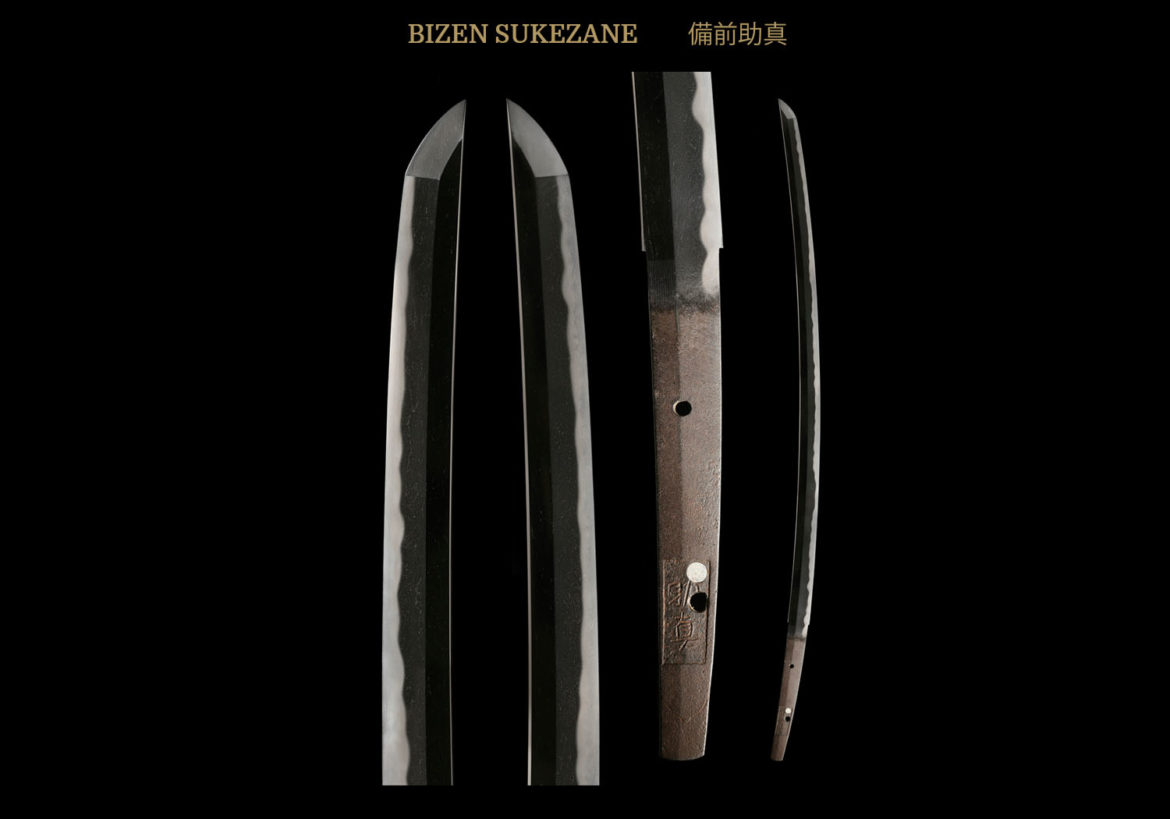
Sukezane (助真) was the son of Fukuoka Ichimonji Sukefusa (福岡一文字助房). He was a renowned smith of the Fukuoka Ichimonji School (福岡一文字系). Around the year 1266 Koreyasu Shinno (惟康親王), who had assumed the duties of Shogun (he was the 7th Kamakura Shogun) called Sukezane (助真) of the Bizen Fukuoka Ichimonji (備前福岡一文字) to Kamakura. After moving to Kamakura, Sukezane (助真) together with his most famous student, Suketsuna (助綱), became known as the Kamakura Ichimonji (鎌倉一文字 ) smiths.
The extant works of Sukezane (助真) and Suketsuna (助綱) are almost all tachi, there are no tantô. The style and workmanship shown in the swords by these smiths continued to bear the old Ichimonji school (一文字系) characteristics. The unique shape of their works with the pronounced width showing almost no tapering toward the point, together with the modest thickness of the cross section, is highlighted by the shape of the medium-sized point called the ikubi kissaki (boar’s head).
There are a good number of works remaining by Sukezane (助真), however, signed examples are relatively rare. No dated examples have been found to date. One of the most famous swords by this smith is called the Nikko Sukezane (日光助真) as it is housed at Nikko Shrine, the burial place of Tokugawa Ieyasu. This sword was a favorite of Tokugawa Ieyasu and is considered the best of the extant works of Sukezane (助真). Of Sukezane’s (助真) remaining works, two have been designated as Kokuho (National Treasures), four tachi and five katana are Juyo Bunkazai, and three tachi and five katana are Juyo Bijitsuhin.
Suketsuna (助綱) worked around the Genkyô Era (元京) 1321. He was the true son of Fujiwara Tsugusuke. He was the adopted son and top student of Sukezane(助真). His remaining works are few and signed examples are exceedingly rare. Like Sukezane(助真), his mei is signed with a boldly carved two-character signature. Like Sukezane (助真) his tachi are in the style of the mid Kamakura period and are of a very sturdy and rugged shape known as ikubi kissaki tachi. Of his remaining swords one tachi has been designated Juyo Bunkazai and two have been designated Juyo Bijitsuhin.
SUGATA: Tachi are made in the style of the Mid Kamakura style. There will be strong koshi zori and very little narrowing of the blade from the hamachi to the kissaki. There will not be much hira-niku, but there will be ha-niku.
JITETSU: The steel texture will be well worked in itame hada mixed with mokume hada. In areas o-mokume hada will be found and it will stand out. There will be chikei and midare-utsuri that will be pronounced.
HAMON: The hamon will generally be a combination of midare-choji and juka-choji. The hamon is of thick nioi structure, showing some small nie grains along with kinsuji. In the works of Sukezane especially, the tops of some of the choji will appear to be almost freestanding balls of temper. The works of Suketsuna will have a somewhat narrower line of nioi with little nie so that the grain of the steel in the hamon will show up. Inazuma is seen along the hamon and from the deep nioi. Ashi will run towards the cutting edge.
BÔSHI: Sukezane: Generally, midare-komi or the continuation of the hamon into the bôshi ending with yakizume (no turn back) or a slight kaeri. Hakikake and inazuma can also be seen on occasion.
Suketsuna: Generally, midare-komi with a slight kaeri.
NAKAGO: Made long and with sori. Also, made kiji-momo and the tip will be kurijiri. The yasurimei will be sujikai. The mei will be cut in two bold characters.
HORIMONO: Bo-hi and futatsu-hi are found on occasion.
MEI: As stated, bold ni-ji mei was used by both smiths and there are no dated examples for either smith.



